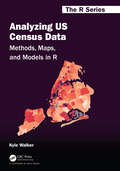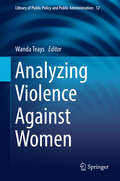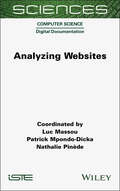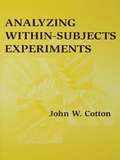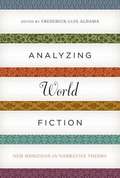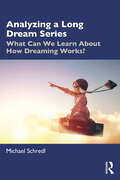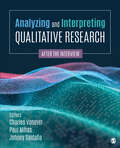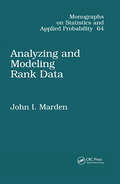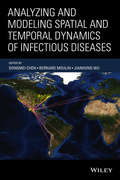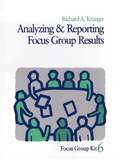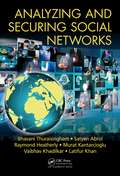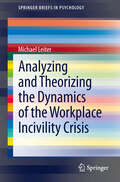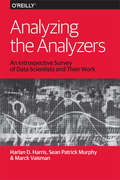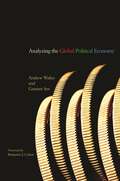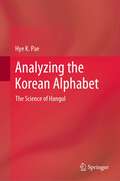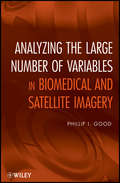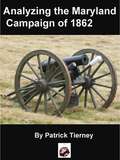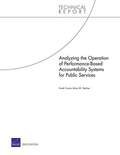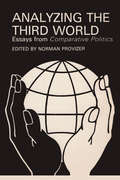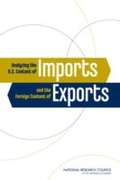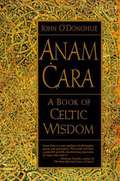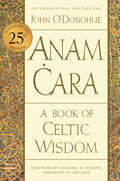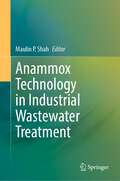- Table View
- List View
Analyzing US Census Data: Methods, Maps, and Models in R (Chapman & Hall/CRC The R Series)
by Kyle WalkerCensus data are widely used by practitioners to understand demographic change, allocate resources, address inequalities, and make sound business decisions. Until recently, projects using US Census data have required proficiency with multiple web interfaces and software platforms to prepare, map, and present data products. This book introduces readers to tools in the R programming language for accessing and analyzing Census data, helping analysts manage these types of projects in a single computing environment. Chapters in this book cover the following key topics: • Rapidly acquiring data from the decennial US Census and American Community Survey using R, then analyzing these datasets using tidyverse tools; • Visualizing US Census data with a wide range of methods including charts in ggplot2 as well as both static and interactive maps; • Using R as a geographic information system (GIS) to manage, analyze, and model spatial demographic data from the US Census; • Working with and modeling individual-level microdata from the American Community Survey’s PUMS datasets; • Applying these tools and workflows to the analysis of historical Census data, other US government datasets, and international Census data from countries like Canada, Brazil, Kenya, and Mexico. Kyle Walker is an associate professor of geography at Texas Christian University, director of TCU’s Center for Urban Studies, and a spatial data science consultant. His research focuses on demographic trends in the United States, demographic data visualization, and software tools for open spatial data science. He is the lead author of a number of R packages including tigris, tidycensus, and mapboxapi.
Analyzing Violence Against Women (Library of Public Policy and Public Administration #12)
by Wanda TeaysThis timely anthology brings into sharp relief the extent of violence against women. Its range is global and far reaching in terms of the number of victims. There are deeply entrenched values that need to be rooted out and laid bare.This text offers a philosophical analysis of the problem, with important insights from the various contributors. Topics range from sexual assault to media violence, prostitution and pornography, domestic violence, and sexual harassment. Each of the four parts include essays which tackle these issues and provide us with tools for bringing about change.The philosophical approaches to the topic give readers insight into the harms of interpersonal violence and its impact on the lives of its victims. Analyzing Violence Against Women calls us to examine public policies and work for systemic change. In the process, we are reminded that the concerns of the discipline of Philosophy encompasses issues with a wider scope.Students will especially benefit from seeing how the various authors grapple with this pressing issue and clarify why we need to bring about change.
Analyzing Websites
by Luc Massou Patrick Mpondo-Dicka Nathalie PinèdeFrom a cluster of interconnected HTML pages to online service platforms, websites are constantly changing in form and function. These transformations have led, on the one hand, to human and social sciences renewing or inventing analytical methodologies; and on the other hand, to a reconsideration of the practices of non-specialists and digital professionals. The Web factory is equally included on the agenda of communication training, according to an alternative approach that is complementary to the one that has been implemented for computer scientists. From these two perspectives and drawing upon several case studies, Analyzing Websites presents epistemological and methodological contributions from researchers in Information and Communication Sciences exploring websites as sociotechnical, semi-discursive and communicational devices. This study covers website design as well as their integration into the digital strategies of organizations in the public, associative and private sectors.
Analyzing Within-subjects Experiments
by John W. CottonMost behavioral scientists know two important concepts -- how to analyze continuous data from randomly assigned treatment groups of subjects and how to assess practice effects for a single group of subjects given a constant treatment at each of several stages of practice. However, except in the case of the repeated measures Latin square design, researchers are not facile in analyzing data from different subjects receiving different treatments at various times in an experiment. This book helps fill the void.
Analyzing Work Groups
by Linda A. Hill Michel AntebyWork groups are the building blocks of organizations. They are found in all areas of an organization, from research and development to customer service, and at all levels, from the executive suite to the factory floor. Some are incredibly successful, while others are dismal failures. Team work is hard work, and all too often groups do not live up to their potential. Provides a framework for analyzing work groups so that group leaders and members can identify actions that will enhance their effectiveness. Helps provide insight into the factors most profoundly shaping the development, dynamics, and effectiveness of task-performing groups and, in particular, group culture, its antecedents, and consequences. To illustrate how the framework is used, it looks at and analyzes an actual work group: the new product team of the Merit Corporation. Examines the impact of leadership style on group culture and outcomes and describes how one leader's individual style can affect the way teams operate and perform.
Analyzing World Fiction
by Frederick Luis AldamaWhy are many readers drawn to stories that texture ethnic experiences and identities other than their own? How do authors such as Salman Rushdie and Maxine Hong Kingston, or filmmakers in Bollywood or Mexico City produce complex fiction that satisfies audiences worldwide? In Analyzing World Fiction, fifteen renowned luminaries use tools of narratology and insights from cognitive science and neurobiology to provide answers to these questions and more. With essays ranging from James Phelan’s “Voice, Politics, and Judgments in Their Eyes Were Watching God” and Hilary Dannenberg’s “Narrating Multiculturalism in British Media: Voice and Cultural Identity in Television” to Ellen McCracken’s exploration of paratextual strategies in Chicana literature, this expansive collection turns the tide on approaches to postcolonial and multicultural phenomena that tend to compress author and narrator, text and real life. Striving to celebrate the art of fiction, the voices in this anthology explore the “ingredients” that make for powerful, universally intriguing, deeply human story-weaving. Systematically synthesizing the tools of narrative theory along with findings from the brain sciences to analyze multicultural and postcolonial film, literature, and television, the contributors pioneer new techniques for appreciating all facets of the wonder of storytelling.
Analyzing a Long Dream Series: What Can We Learn About How Dreaming Works?
by Michael SchredlAnalyzing a Long Dream Series provides an extraordinary insight into the richness and variability of dreams, considering over 12,000 dreams that have been recorded for more than 30 years.Internationally recognized dream scientist Michael Schredl opens up his own personal dream series, offering a unique window into the interplay between waking life and dreaming. The book considers a huge range of dream topics, including family, friends, schoolmates, colleagues, erotic dreams, alongside the appearance of everyday objects. It also discusses rarer themes such as pain perception, temperature perception, and typical dreams about toilets, exams, and teeth. As the author is both the dreamer and the researcher, questions like why we dream about topics we have never experienced in waking life – for example, about the pain of being shot in the stomach – can be addressed, shedding light on the creative nature of dreams. The in-depth analyses provided in this book attempt to answer the field's most profound questions: why do we dream every night, and why do we dream in such creative ways about the issues that are important to us in waking life? The dreams analyzed question existing dream theories such as simulation theories, and the author proposes a function of recalled dreams for creative problem solving and provides ideas for future research.This fascinating book is an essential read for all dream researchers and students of the psychology of dreams.
Analyzing and Interpreting Qualitative Research: After the Interview
by Johnny Saldaña Charles Vanover Paul MihasThis text provides comprehensive coverage of the key methods for analyzing, interpreting, and writing up qualitative research in a single volume, and drawing on the expertise of major names in the field. Covering all the steps in the process of analyzing, interpreting, and presenting findings in qualitative research, the authors utilize a consistent chapter structure that provides novice and seasoned researchers with pragmatic, "how-to" strategies. Each chapter introduces the method; uses one of the authors′ own research projects as a case study of the method described; shows how the specific analytic method can be used in other types of studies; and concludes with questions and activities to prompt class discussion or personal study.
Analyzing and Interpreting Qualitative Research: After the Interview
by Johnny Saldaña Charles Vanover Paul MihasThis text provides comprehensive coverage of the key methods for analyzing, interpreting, and writing up qualitative research in a single volume, and drawing on the expertise of major names in the field. Covering all the steps in the process of analyzing, interpreting, and presenting findings in qualitative research, the authors utilize a consistent chapter structure that provides novice and seasoned researchers with pragmatic, "how-to" strategies. Each chapter introduces the method; uses one of the authors′ own research projects as a case study of the method described; shows how the specific analytic method can be used in other types of studies; and concludes with questions and activities to prompt class discussion or personal study.
Analyzing and Modeling Rank Data (Chapman & Hall/CRC Monographs on Statistics and Applied Probability)
by John I MardenThis book is the first single source volume to fully address this prevalent practice in both its analytical and modeling aspects. The information discussed presents the use of data consisting of rankings in such diverse fields as psychology, animal science, educational testing, sociology, economics, and biology. This book systematically presents th
Analyzing and Modeling Spatial and Temporal Dynamics of Infectious Diseases
by Jianhong Wu Bernard Moulin Dongmei ChenFeatures modern research and methodology on the spread of infectious diseases and showcases a broad range of multi-disciplinary and state-of-the-art techniques on geo-simulation, geo-visualization, remote sensing, metapopulation modeling, cloud computing, and pattern analysisGiven the ongoing risk of infectious diseases worldwide, it is crucial to develop appropriate analysis methods, models, and tools to assess and predict the spread of disease and evaluate the risk. Analyzing and Modeling Spatial and Temporal Dynamics of Infectious Diseases features mathematical and spatial modeling approaches that integrate applications from various fields such as geo-computation and simulation, spatial analytics, mathematics, statistics, epidemiology, and health policy. In addition, the book captures the latest advances in the use of geographic information system (GIS), global positioning system (GPS), and other location-based technologies in the spatial and temporal study of infectious diseases.Highlighting the current practices and methodology via various infectious disease studies, Analyzing and Modeling Spatial and Temporal Dynamics of Infectious Diseases features:Approaches to better use infectious disease data collected from various sources for analysis and modeling purposesExamples of disease spreading dynamics, including West Nile virus, bird flu, Lyme disease, pandemic influenza (H1N1), and schistosomiasisModern techniques such as Smartphone use in spatio-temporal usage data, cloud computing-enabled cluster detection, and communicable disease geo-simulation based on human mobilityAn overview of different mathematical, statistical, spatial modeling, and geo-simulation techniquesAnalyzing and Modeling Spatial and Temporal Dynamics of Infectious Diseases is an excellent resource for researchers and scientists who use, manage, or analyze infectious disease data, need to learn various traditional and advanced analytical methods and modeling techniques, and become aware of different issues and challenges related to infectious disease modeling and simulation. The book is also a useful textbook and/or supplement for upper-undergraduate and graduate-level courses in bioinformatics, biostatistics, public health and policy, and epidemiology.
Analyzing and Reporting Focus Group Results
by Professor Richard A. KruegerRichard Krueger offers a rich and valuable discussion of focus group analysis that is sure to become a major guide in future focus group efforts. Analysis of focus group data is different from analysis of data collected through other qualitative methodologies and this presents new challenges to researchers. This book overviews important principles guiding focus group research, suggests a systematic and verifiable analysis strategy. Krueger is not doctrinaire: he offers multiple approaches and invites others to share their strategies for analysis. The book is helpful for academic audiences, focus group practitioners and the occasional moderator. The straightforward approach contains hundreds of helpful tips.
Analyzing and Securing Social Networks
by Latifur Khan Bhavani Thuraisingham Murat Kantarcioglu Vaibhav Khadilkar Satyen Abrol Raymond HeatherlyAnalyzing and Securing Social Networks focuses on the two major technologies that have been developed for online social networks (OSNs): (i) data mining technologies for analyzing these networks and extracting useful information such as location, demographics, and sentiments of the participants of the network, and (ii) security and privacy technolo
Analyzing and Theorizing the Dynamics of the Workplace Incivility Crisis (SpringerBriefs in Psychology #8)
by Michael LeiterContemporary worklife builds upon a foundation for teamwork among skilled and dedicated people. Despite the utility of supportive working relationships and despite extensive consulting activity on leadership and team building, employees complain extensively about mistreatment by their bosses and colleagues. Analyzing and Theorizing the Dynamics of the Workplace Incivility Crisis presents a theoretic framework for considering the fundamental issues of group dynamics and individual psychology that lie behind this ongoing workplace incivility crisis. It contextualizes the need for belonging as a motivation that shapes expressed social behaviour and intensifies received social behaviour. Looking at cognitive elements as well as rudeness rationales that pertain to workplace incivility and its justification, this work maps social constructs, including the role of team leadership, that lead to setting implicit social norms. In addition to formulating a theoretical framework, Analyzing and Theorizing the Dynamics of the Workplace Incivility Crisis considers methods to address the dynamics that perpetuate incivility at work and actively points at setting an action agenda to evaluate their impact.
Analyzing the Analyzers: An Introspective Survey of Data Scientists and Their Work
by Sean Murphy Marck Vaisman Harlan HarrisDespite the excitement around "data science," "big data," and "analytics," the ambiguity of these terms has led to poor communication between data scientists and organizations seeking their help. In this report, authors Harlan Harris, Sean Murphy, and Marck Vaisman examine their survey of several hundred data science practitioners in mid-2012, when they asked respondents how they viewed their skills, careers, and experiences with prospective employers. The results are striking.Based on the survey data, the authors found that data scientists today can be clustered into four subgroups, each with a different mix of skillsets. Their purpose is to identify a new, more precise vocabulary for data science roles, teams, and career paths.This report describes:Four data scientist clusters: Data Businesspeople, Data Creatives, Data Developers, and Data ResearchersCases in miscommunication between data scientists and organizations looking to hireWhy "T-shaped" data scientists have an advantage in breadth and depth of skillsHow organizations can apply the survey results to identify, train, integrate, team up, and promote data scientists
Analyzing the Global Political Economy
by Andrew Walter Gautam SenIdeally suited to upper-undergraduate and graduate students, Analyzing the Global Political Economy critically assesses the convergence between IPE, comparative political economy, and economics. Andrew Walter and Gautam Sen show that a careful engagement with economics is essential for understanding both contemporary IPE and for analyzing the global political economy. The authors also argue that the deployment of more advanced economic theories should not detract from the continuing importance for IPE of key concepts from political science and international relations. IPE students with little or no background in economics will therefore find this book useful, and economics students interested in political economy will be alerted to the comparative strengths of political science and other social science disciplines. A concise look at the foundations of analysis in the political economy of global trade, money, finance, and investment Suitable for upper-undergraduate and graduate students with some or no economic background Techniques and findings from a range of academic disciplines, including international relations, political science, economics, sociology, and history Further reading and useful weblinks including a range of relevant data sources, listed in each chapter
Analyzing the Korean Alphabet: The Science of Hangul
by Hye K. PaeThis book provides comprehensive coverage of the Korean alphabet, Hangul, and includes a synthesis of research findings relating to reading in the non-Roman alphabet. This, in turn, contributes to the science of reading through an understanding of reading mechanisms that are essential for all writing systems, and that are particular for a given writing system. Hangul has been recognized as “the world’s best alphabet,” “one of the great intellectual achievements of Mankind,” and “alphabet’s epitome, a star among alphabets” by international linguists and historians. It is known that writing systems have evolved based on the ecological principle that visual signs are culturally selected to match objects found in natural scenes through selection pressures for optimal visual processing. However, Hangul is an exception. It was purposely invented by King Sejong in the 15th century to combat the illiteracy prevalent at the time. The chapters excavate the historical background of Hangul, and the unique characteristics of Hangul that contribute to learnability for emergent readers and efficiency for skilled readers. The author presents empirical evidence of psycholinguistic research into reading Hangul, building theories and presenting implications for the science of reading (psycholinguistics) and the science of writing (grapholinguistics). This book is relevant to students, researchers, and practitioners in applied linguistics, psycholinguistics, language studies, reading studies, and grammatology, with a particular focus on the Korean alphabet.
Analyzing the Large Number of Variables in Biomedical and Satellite Imagery
by Phillip I. GoodThis book grew out of an online interactive offered through statcourse.com, and it soon became apparent to the author that the course was too limited in terms of time and length in light of the broad backgrounds of the enrolled students. The statisticians who took the course needed to be brought up to speed both on the biological context as well as on the specialized statistical methods needed to handle large arrays. Biologists and physicians, even though fully knowledgeable concerning the procedures used to generate microaarrays, EEGs, or MRIs, needed a full introduction to the resampling methods--the bootstrap, decision trees, and permutation tests, before the specialized methods applicable to large arrays could be introduced. As the intended audience for this book consists both of statisticians and of medical and biological research workers as well as all those research workers who make use of satellite imagery including agronomists and meteorologists, the book provides a step-by-step approach to not only the specialized methods needed to analyze the data from microarrays and images, but also to the resampling methods, step-down multi-comparison procedures, multivariate analysis, as well as data collection and pre-processing. While many alternate techniques for analysis have been introduced in the past decade, the author has selected only those techniques for which software is available along with a list of the available links from which the software may be purchased or downloaded without charge. Topical coverage includes: very large arrays; permutation tests; applying permutation tests; gathering and preparing data for analysis; multiple tests; bootstrap; applying the bootstrap; classification methods; decision trees; and applying decision trees.
Analyzing the Maryland Campaign of 1862
by Patrick TierneyA short analysis of the decisions and actions that led to Gen Lee's invasion of Maryland in 1862
Analyzing the Operation of Performance-Based Accountability Systems for Public Services
by Brian M. Stecher Frank CammThis report describes a framework used to organize available empirical information on one form of performance-based management, a performance-based accountability system (PBAS), which identifies individuals or organizations that must change their behavior to improve an activity's performance, an incentive structure to motivate those changes, and measures tailored to inform the incentive structure.
Analyzing the Third World: Essays from Comparative Politics
by Norman ProvizerFirst Published in 2017. Routledge is an imprint of Taylor & Francis, an Informa company.
Analyzing the U.S. Content of Imports and the Foreign Content of Exports
by National Research Council of the National AcademiesThe National Academies Press (NAP)--publisher for the National Academies--publishes more than 200 books a year offering the most authoritative views, definitive information, and groundbreaking recommendations on a wide range of topics in science, engineering, and health. Our books are unique in that they are authored by the nation's leading experts in every scientific field.
Anam Cara
by John O'DonohueDiscover the Celtic Circle of Belonging John O'Donohue, poet, philosopher, and scholar, guides you through the spiritual landscape of the Irish imagination. In Anam Cara, Gaelic for "soul friend," the ancient teachings, stories, and blessings of Celtic wisdom provide such profound insights on the universal themes of friendship, solitude, love, and death as: Light is generous The human heart is never completely born Love as ancient recognitionThe body is the angel of the soul Solitude is luminous Beauty likes neglected places The passionate heart never ages To benatural is to be holy Silence is the sister of the divine Death as an invitation to freedom
Anam Cara [Twenty-fifth Anniversary Edition]: A Book of Celtic Wisdom
by John O'Donohue“In this twenty-fifth anniversary edition, you will find John a “soul friend” on your own journey through life, offering support and solace, clarity, and consciousness—expanding narratives that invite you to experience relationships with people, nature, and even your inner world in new ways that nurture well-being and resilience in these challenging times.” —Daniel J. Siegel, MD, Neuropsychiatrist and New York Times Bestselling AuthorA special twenty-fifth anniversary edition of the classic work of Celtic spirituality and mysticism by beloved poet and philosopher, John O'Donohue, with a new introduction by the President of Ireland, Michael D. Higgins, an afterword by the late author’s brother, Pat O'Donohue, and insightful material from O'Donohue's circle of close friends.In this revered classic, John O’Donohue excavates themes of friendship, belonging, solitude, creativity and the imagination, among many others. Widely recognized for bringing Celtic spirituality into modern dialogue, his unique insights from the ancient world speak with urgency for our need to rediscover the thresholds of the soul. With lyrical wisdom and fluency, O'Donohue encourages pathways of discovery to come home to the natural rhythm in ourselves in sacred connection with one another and the landscapes we inhabit. This timeless collection nourishes the heart and elevates the spirit. It is "a book to read and reread forever.” (Irish Times)
Anammox Technology in Industrial Wastewater Treatment
by Maulin P. ShahAmmonia in wastewater causes the eutrophication of water bodies and the subsequent depletion of dissolved oxygen. In addition, certain forms of nitrogen such as ammonia, nitrite, and nitrate are highly toxic to aquatic life. Although there are several biological and physical–chemical techniques for the removal of ammoniacal nitrogen compounds, including air stripping and breakpoint chlorination, which have been widely applied, a microbiological or microbe-based approach is attractive because it is based on sustainable technologies. In this regard, ammonia-oxidizing bacteria have recently gained great interest, specifically in wastewater treatment plants for the removal of ammoniacal nitrogen especially, owing to its relatively low capital cost, eco-friendliness, and high efficiency when compared with conventional cleanup technologies. This book provides specific and advanced knowledge on the microbial ecology of ammonia-oxidizing bacteria and their diversity and functions in the treatment of toxic pollutants present in wastewater. The book thus serves as a valuable resource for engineers, scientists, and managers who require an excellent introductory and advanced knowledge of the field, professionals who are working or interested in the environmental microbiology or bioremediation field, and students learning about environmental biotechnology and microbiology.
